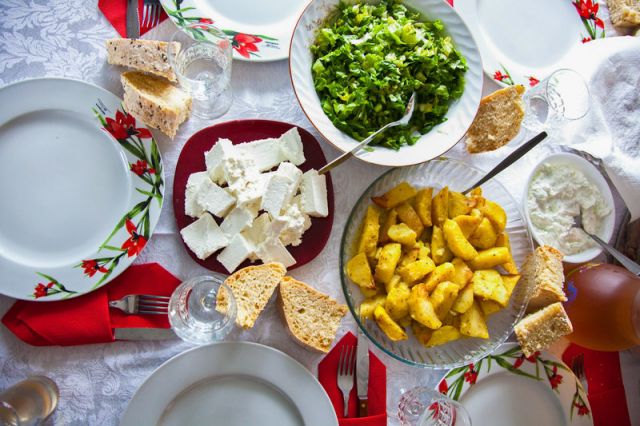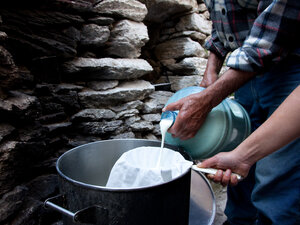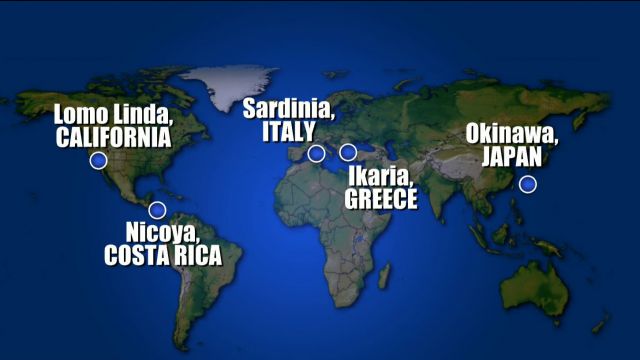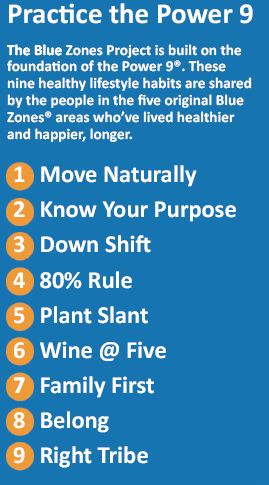Would You Like to Live to a Healthy 100 Years? Here's How - Blue Zones (Video)
by N.Morgan

The life expectancy of an American born today averages around 78.2 years. But this year, over 70,000 Americans have reached their 100th birthday. What are they doing that the average American isn’t?
To answer the question, we teamed up with National Geographic to find the world’s longest-lived people and study them. We knew most of the answers lied within their lifestyle and environment (The Danish Twin Study established that only about 20% of how long the average person lives is determined by genes). Then we worked with a team of demographers to find pockets of people around the world with the highest life expectancy, or with the highest proportions of people who reach age 100.
We found five places that met our criteria:
- Barbagia region of Sardinia – Mountainous highlands of inner Sardinia with the world’s highest concentration of male centenarians.
- Ikaria, Greece – Aegean Island with one of the world’s lowest rates of middle age mortality and the lowest rates of dementia.
- Nicoya Peninsula, Costa Rica – World’s lowest rates of middle age mortality, the second highest concentration of male centenarians.
- Seventh Day Adventists – Highest concentration is around Loma Linda, California. They live 10 years longer than their North American counterparts.
- Okinawa, Japan – Females over 70 are the longest-lived population in the world.
We then assembled a team of medical researchers, anthropologists, demographers, and epidemiologists to search for evidence-based common denominators among all places. We found nine.

1. Move Naturally
The world’s longest-lived people don’t pump iron, run marathons or join gyms. Instead, they live in environments that constantly nudge them into moving without thinking about it. They grow gardens and don’t have mechanical conveniences for house and yard work.
2. Purpose
The Okinawans call it “Ikigai” and the Nicoyans call it “plan de vida;” for both it translates to “why I wake up in the morning.” Knowing your sense of purpose is worth up to seven years of extra life expectancy
3. Down Shift
Even people in the Blue Zones experience stress. Stress leads to chronic inflammation, associated with every major age-related disease. What the world’s longest-lived people have that we don’t are routines to shed that stress. Okinawans take a few moments each day to remember their ancestors, Adventists pray, Ikarians take a nap and Sardinians do happy hour.
.jpg)
4. 80% Rule
“Hara hachi bu” – the Okinawan, 2500-year old Confucian mantra said before meals reminds them to stop eating when their stomachs are 80 percent full. The 20% gap between not being hungry and feeling full could be the difference between losing weight or gaining it. People in the Blue Zones eat their smallest meal in the late afternoon or early evening and then they don’t eat any more the rest of the day.
5. Plant Slant
Beans, including fava, black, soy and lentils, are the cornerstone of most centenarian diets. Meat—mostly pork—is eaten on average only five times per month. Serving sizes are 3-4 oz., about the size of a deck of cards.
6. Wine @ 5
People in all Blue Zones (except Adventists) drink alcohol moderately and regularly. Moderate drinkers outlive non-drinkers. The trick is to drink 1-2 glasses per day (preferably Sardinian Cannonau wine), with friends and/or with food. And no, you can’t save up all week and have 14 drinks on Saturday.
7. Belong
All but five of the 263 centenarians we interviewed belonged to some faith-based community. Denomination doesn’t seem to matter. Research shows that attending faith-based services four times per month will add 4-14 years of life expectancy.
8. Loved Ones First
Successful centenarians in the Blue Zones put their families first. This means keeping aging parents and grandparents nearby or in the home (It lowers disease and mortality rates of children in the home too.). They commit to a life partner (which can add up to 3 years of life expectancy) and invest in their children with time and love (They’ll be more likely to care for you when the time comes).
9. Right Tribe
The world’s longest-lived people chose–or were born into–social circles that supported healthy behaviors, Okinawans created ”moais”–groups of five friends that committed to each other for life. Research from the Framingham Studies shows that smoking, obesity, happiness, and even loneliness are contagious. So the social networks of long-lived people have favorably shaped their health behaviors.
.png)
To make it to age 100, you have to have won the genetic lottery. But most of us have the capacity to make it well into our early 90’s and largely without chronic disease. As the Adventists demonstrate, the average person’s life expectancy could increase by 10-12 years by adopting a Blue Zones lifestyle.

The people who live in the Blue Zones — five regions in Europe, Latin America, Asia, and the U.S. researchers have identified as having the highest concentrations of centenarians in the world — move their bodies a lot. They have social circles that reinforce healthy behaviors. They take time to de-stress. They’re part of communities, often religious ones. And they’re committed to their families.
However, it is what they put in their mouths, how much and when is worth a close look, too. And that’s why Dan Buettner, a National Geographic explorer, and author who struck out on a quest in 2000 to find the lifestyle secrets to longevity, has written a follow up to his original book on the subject. The new book, called The Blue Zones Solution, is aimed at Americans and is mostly about eating.
Why should we pay attention to what the people in the relatively isolated Blue Zone communities eat? Because, as Buettner writes, their more traditional diets harken back to an era before we Americans were inundated with greasy fast food and sugar. And to qualify as a Blue Zone, these communities also have to be largely free of afflictions like heart disease, obesity, cancer, and diabetes. So clearly they’re doing something right.
You can get the backstory in this excerpt of the original book, which was published in 2008. But in a nutshell, Buettner in 2004 rounded up a bunch of anthropologists, demographers, epidemiologists and other researchers to travel around the world to study communities with surprisingly high percentages of centenarians. He and the scientists interviewed hundreds of people who’d made it to age 100 about how they lived, then did a lot of number crunching to figure out what they had in common.
A year after that book was published, the team announced they’d narrowed it down to five places that met all their criteria. They gave them official Blue Zone status: Ikaria, Greece; Okinawa, Japan; Ogliastra Region, Sardinia; Loma Linda, Calif.; and Nicoya Peninsula, Costa Rica.
In the new book, which was released April 7, Buettner distills the researchers’ findings on what all the Blue Zones share when it comes to their diet. Here’s a taste:
- Stop eating when your stomach is 80 percent full to avoid weight gain.
- Eat the smallest meal of the day in the late afternoon or evening.
- Eat mostly plants, especially beans. And eat meat rarely, in small portions of 3 to 4 ounces. Blue Zoners eat portions this size just five times a month, on average.
- Drink alcohol moderately and regularly, i.e. 1-2 glasses a day.
The book also features “top longevity foods” from each Blue Zone, some of which we found pretty intriguing.
Ikaria, Greece
You may remember this Blue Zone from Buettner’s wonderful 2012 New York Times Magazine article entitled “The Island Where People Forget To Die.”
As we’ve reported, health researchers have long praised the Mediterranean diet for promoting brain and physical health and keeping chronic diseases at bay. So what makes the diet of the people on Ikaria, a small island in the Aegean Sea, so special?
“Their tradition of preparing the right foods, in the right way, I believe, has a lot to do with the island’s longevity,” writes Buettner.
And “what set it apart from other places in the region was its emphasis on potatoes, goat’s milk, honey, legumes (especially garbanzo beans, black-eyed peas, and lentils), wild greens, some fruit and relatively small amounts of fish.”
Ikaria has a few more “top longevity foods:” feta cheese, lemons and herbs like sage and marjoram that Ikarians use in their daily tea. What’s missing that we usually associate with Greece? Lamb. The Ikarians do eat some goat meat, but not often.
Okinawa, Japan
Buettner calls the islands of Okinawa a kind of “Japanese Hawaii” for their laid-back vibe, beaches and fabulous weather. Okinawa also happens to have one of the highest centenarian ratios in the world: About 6.5 in 10,000 people live to 100 (compare that with 1.73 in 10,000 in the U.S.)
Centenarians on Okinawa have lived through a lot of upheaval, so their dietary stories are more complicated than some of the other Blue Zones. As Buettner writes, many healthful Okinawan “food traditions foundered mid-century” as Western influence brought about changes in food habits. After 1949, Okinawans began eating fewer healthful staples like seaweed, turmeric and sweet potato and more rice, milk and meat.
Still, Okinawans have nurtured the practice of eating something from the land and the sea every day. Among their “top longevity foods” are bitter melons, tofu, garlic, brown rice, green tea and shitake mushrooms.
Sardinia, Italy
On this beautiful island in the middle of the Mediterranean, the ratio of centenarian men to women is one to one. That’s quite unusual because in the rest of the world, it’s five women to every one man who live that long.

The sharp pecorino cheese made from the milk of grass-fed sheep in Sardinia, has high levels of omega-3 fatty acids.
Gianluca Colla/Courtesy of Blue Zones
Buettner writes that the Sardinians explain their exceptional longevity with their assets such as “clean air,” “locally produced wine,” or because they “make love every Sunday.” But when Buettner brought along a researcher to dig deeper, they found that pastoralism, or shepherding livestock from the mountains to the plains, was most highly correlated with reaching 100.
So what are those ancient Sardinian shepherds eating? You guessed it: goat’s milk and sheep’s cheese — some 15 pounds of cheese per year, on average. Also, a moderate amount of carbs to go with it, like flatbread, sourdough bread and barley. And to balance those two food groups out, Sardinian centenarians also eat plenty of fennel, fava beans, chickpeas, tomatoes, almonds, milk thistle tea and wine from Grenache grapes.
Loma Linda, Calif.
There’s a Blue Zone community in the U.S.? We were as shocked to learn this as you may be. Its members are Seventh-day Adventists who shun smoking, drinking and dancing and avoid TV, movies and other media distractions.

Tofu links sold in Loma Linda, Calif. The Blue Zones research shows that adherents of the Adventist diet, which is mostly plant-based, have lowest rates of heart disease and diabetes in the U.S. and very low rates of obesity.
David Mclain/Courtesy of Blue Zones
They also follow a “biblical” diet focused on grains, fruits, nuts and vegetables, and drink only water. (Some of them eat small amounts of meat and fish.) Sugar is taboo, too. As one Loma Linda centenarian tells Buettner: “I’m very much against sugar except natural sources like fruit, dates or figs. I never eat refined sugar or drink sodas.”
Gary Fraser, a cardiologist and epidemiologist at Loma Linda University and an Adventist himself, has found in studies that Adventists who follow the religion’s teachings lived about 10 years longer than people who didn’t. Another key insight? Pesco-vegetarians in the community, who ate a plant-based diet with up to one serving of fish a day, lived longer than vegan Adventists.
Their top foods include avocados, salmon, nuts, beans, oatmeal, whole wheat bread and soy milk.
Nicoya Peninsula, Costa Rica
We’d love to be invited for dinner by a centenarian here, where they #putaneggonit all the time. One delicious-sounding meal Buettner was served by a 99-year-old woman (who’s now 107) consisted of rice and beans, garnished with cheese and cilantro, on corn tortillas, with an egg on top.
As Buettner writes, “The big secret of the Nicoyan diet was the ‘three sisters’ of Meso-American agriculture: beans, corn and squash.” Those three staples, plus papayas, yams, bananas and peach palms (a small Central American oval fruit high in vitamins A and C), are what fuel the region’s elders over the century.
Granted, it’s not easy to emulate the Blue Zoners if you live in the U.S. where you’re likely to be tempted with bacon and cupcakes every day. And maybe you don’t want to become a vegan.
But Buettner has plenty to say about simple ways Americans could live like these isolated tribes of exceptional health in The Blue Zone Solution. That’s what he’s focused on now with the Blue Zone Project: helping communities adopt the cross-cutting tenets of a healthful lifestyle. So far, the project has gotten several towns — and U.S. states — to sign on.
For recipes from the Blue Zones with the ingredients above, check out the web site. And for more photos from the Blue Zones, head to National Geographic.
We have an affiliate program designed for content creators and Affiliate marketers, who would like to sell this product, please click here for affiliate program details. Our affiliate program is designed to help you monetize your screen time.

References:


Comments
Post a Comment